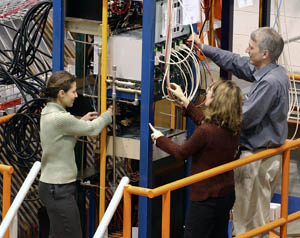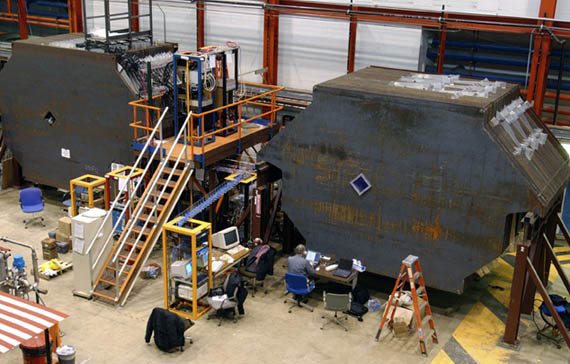 |
|
Dance of the Planes by Kurt Riesselmann Less than four years after breaking ground at Fermilab for an underground complex consisting of 4,000 feet of tunnels and two experimental halls, scientists of the Main Injector Neutrino Oscillation Search collaboration are preparing for the first components of a 1,000-ton neutrino detector to go underground. Technicians will lower the first of 282 octagonal-shaped detector planes—each weighing more than a pickup truck—down a 350-foot shaft on the Fermilab site in March. The new detector will be the second massive detector assembled by the international MINOS collaboration. Last year the collaboration finished the installation of a five-times-larger 'far detector' half a mile underground in a mine in Soudan, Minnesota. Scientists will use the two detectors to unravel the mystery of neutrino oscillations by measuring the evolution of a man-made neutrino beam traveling 450 miles through rock from Fermilab to Soudan.
"In the last couple of months our technicians have practiced every single step required in handling the planes," said MINOS physicist Catherine James. "Last August we determined the truck route to bring the planes from the storage location to the shaft. We expect to bring over a truckload a day, escorted by security vehicles." On March 4, Fermilab will assume responsibility for the detector hall. Until then, Ragnar Benson, Inc. and its construction workers are finishing the interior of the underground halls. The biggest jobs underground have been the plumbing and specialized air-handling units for the tunnels. Sump pumps remove 300 gallons of water per minute from the tunnels. Because of the good quality of the water, Fermilab has begun to use it as cooling water, supplementing other water sources. "Ragnar Benson has been a great contractor to work with. We met all project deadlines without a problem," said Fermilab engineer Elaine McCluskey who supervised the $20.4-million Ragnar Benson construction contract, which also includes the construction of a 6,900-square-foot service building on top of the MINOS access shaft. "The deployment of the detector can proceed as planned."
Beginning in April technicians will install up to five detector planes per day, arranging the planes like the slices of a loaf of bread. During the evening shifts scientists will test the functionality of each plane and hook them up to the MINOS data acquisition (DAQ) system. "The whole collaboration will take shifts," said Fermilab's Peter Shanahan, one of more than 200 physicists from six countries that are part of the collaboration. "We will have a lot of experts coming in from other institutions." Shanahan and a group of scientists have practiced connecting detector planes to the DAQ system using nine of the planes in storage. At the end of February the test setup recorded its first cosmic rays, extraterrestrial particles that penetrate the earth's atmosphere with high energy. The MINOS detector, when complete, will rely on neutrinos produced at Fermilab rather than cosmic rays. Neutrinos are particles without electric charge that barely interact with matter. As a matter of fact, neutrinos can traverse the entire earth without causing a single collision. Scientists so far have identified three types of neutrinos called electron neutrino, muon neutrino, and tau neutrino. The MINOS experiment will focus on bursts of muon neutrinos produced by Fermilab's Main Injector accelerator. Every two seconds, the accelerator slams a package of 120-GeV protons into a graphite target, producing a wealth of secondary particles. A fast-pulsing magnet, called a focusing horn, selects the right types of particles to produce an intense beam of muon neutrinos. The neutrinos will travel about 1,000 feet through rock before entering the MINOS near detector. A tiny fraction of the particles will produce a signal inside the detector, just enough for scientists to verify the composition of the muon neutrino beam. The rest of the beam will continue its journey close to the speed of light straight through the earth to Soudan, Minnesota. The far detector will also record signals from the neutrino beam, about two thousandths of a second after the neutrinos have left the near detector. Comparing the results, scientists can precisely determine how many muon neutrinos have "oscillated" into electron neutrinos or tau neutrinos, a process allowed according to quantum theory. Reports of neutrino oscillations have come from several experiments, including Super-Kamiokande in Japan and the Sudbury Neutrino Observatory in Canada. The MINOS collaboration will examine the intricacies of the mixing process in greater detail, providing crucial pieces of information to solve the neutrino puzzle.
Work on the beam line for the MINOS experiment has progressed well. The project has stayed on schedule since the completion of the excavation in November 2002. Technicians have finished the installation of approximately twenty large magnets that are necessary to extract protons from the Main Injector and to guide the charged particles to the neutrino-producing target, a distance of about 1,200 feet. "Except for three kicker magnets, all the major magnets are installed," said Nancy Grossman, deputy head of the Neutrinos at the Main Injector (NuMI) department. "We are now working on shielding, instrumentation and small correcting magnets." Lowering 20-foot accelerator magnets and other equipment down a long, narrow shaft into a tunnel has been a first for Fermilab and its technicians. All other accelerator tunnels at the lab are only tens of feet below the surface. In contrast, the NuMI target hall is about 150 feet underground. "It's a non-trivial task," Grossman said about the beam line installation. "We had a few problems with the cranes, which we have resolved. We plan to be done with the main shielding of the target hall in March. The focusing horns will go underground around May. If we fall behind in schedule, we have a contingency to go to two shifts." The beam line will see its first particles at the end of the year. MINOS scientists expect to see the first man-made neutrinos in early 2005, catching on average four neutrinos per day in the far detector. "It is wonderful to see the project, with input from so many people, come together like this," said Stanley Wojcicki, physics professor at Stanford University and cospokesperson of the MINOS collaboration. "We can hardly wait to see the first neutrinos and to begin detailed studies of their mysterious nature." On the Web:
NuMI-MINOS Homepage: |
| last modified 3/7/2004 email Fermilab |
FRLsDFx9eyfrPXgV


